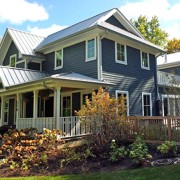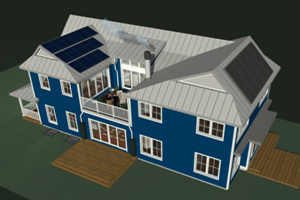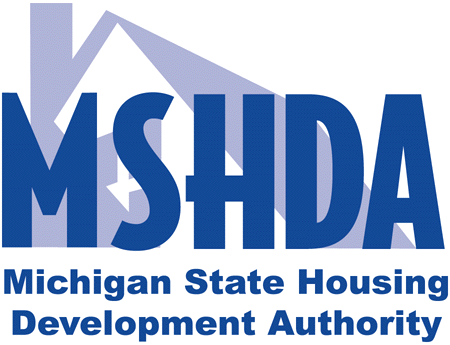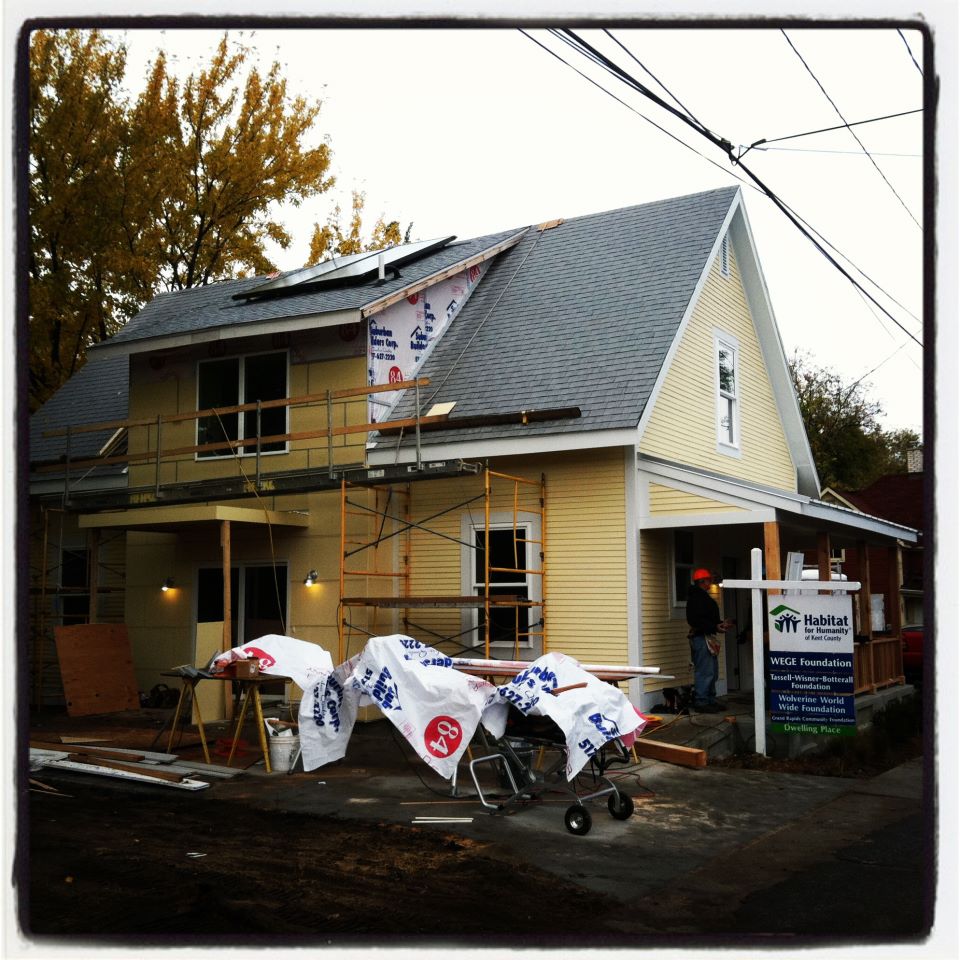There are 16,194 LEED for Homes certified units in the U.S as Jan 9th. 537 have been completed by . That is about 4% of the projects!


There are 16,194 LEED for Homes certified units in the U.S as Jan 9th. 537 have been completed by . That is about 4% of the projects!

A Glencoe, IL home has just been awarded a Platinum rating by the United States Green Building Council (USGBC) LEED for Homes program, the highest level possible. The house is only the second new-construction LEED Platinum home in the State of Illinois and the first LEED Platinum home on the North Shore. View the LEED Project Snapshot

The Washington Avenue home was designed by Nathan Kipnis, AIA of Kipnis Architecture + Planning of Evanston and built by Scott Simpson Builders of Northbrook. Owners Barry and Natalie Slotnick moved into the house in April of 2011 with their two young children.

This home is unique in its commitment to staying within the aesthetic of the surrounding community while implementing a wide range of green goals. It’s one of the few LEED homes to take a non-modernist approach to its exterior, as well as being informed by traditional low-impact building philosophies. The home is classic in its style, form and proportions, yet modern in its use of materials, colors and systems. Green features include passive, natural ventilation; passive solar heating and cooling; water-efficient indoor plumbing fixtures including a waterless urinal; low and no-VOC finishes and fixtures; standing seam metal roofing; cement fiberboard siding; and prefabricated framing.
Architect Kipnis states, “The house was built for 40% of the cost of the first LEED Platinum home in Illinois and in a style that appeals to a much wider cross section of the public. While these homes can be thought of as pioneering efforts, if the goal is to engage the public then the design should be contextual to neighborhood and not be aesthetically shocking. The Slotnick’s home is a perfect example of this.”

LEED for Homes is a voluntary, third-party certification program developed by residential experts and experienced builders. LEED promotes the design and construction of high performance green homes, and encourages the adoption of sustainable practices throughout the building industry.
Download the LEED Project Snapshot
Contacts:
Barry Slotnick – 847-875-4920; bslotnick@varisport.com
Nathan Kipnis – 847-864-9650; nkipnis@kipnisarch.com

Designed by Young & Young Architects, the contemporary “green” house is constructed of stone, cement plaster, copper, and glass. A bridge connects two sections of the home. The landscaping consists of indigenous, drought-resistant plants and grasses. all the materials used to build an ultra-green home in Bloomfield Township came from within a 500-mile radius, to meet LEED (Leadership in Energy and Environmental Design) requirements. But the idea for the house took root thousands of miles away.

“We travel to South America a lot, and when we’d fly over the jungle, we’d notice large swaths being clear-cut and burned,” says Art Roffey, who owns the home with his wife, Gail Danto.
“We spent time with the tribal people, and they would talk in terms of being custodians of their land, but they were seeing it disappear,” he says. “That was a big influence for wanting to build our home.”
The couple also noticed the recession of glaciers in the Andes. So, when they decided to build their house on Indian Pond, they were keenly aware of the environment.
The 1950s-era home formerly on the site was deconstructed, and all the materials were recycled and donated to the non-profit Architectural Salvage Warehouse of Detroit.
“We wanted to build a house that was beautiful and elegant and also honor the environment at the same time,” Danto says.
By all accounts, they accomplished that, with the assistance of Bloomfield Hills-based Young & Young Architects (Don Paul Young was the principal architect); LEED consultant Jim Newman, from Newman Consulting Inc. in Bloomfield Hills; Joseph Maiorano, from the Artisans Group in Royal Oak; and interior designer Diane Hancock, of Diane Hancock Designs.
At press time, the house was under review by the U.S. Green Building Council for Platinum certification — the highest level. The design also resulted in five 2011 Detroit Home Design Awards last March.At press time, the house was under review by the U.S. Green Building Council for Platinum certification — the highest level. The design also resulted in five 2011 Detroit Home Design Awards last March.

The home, which Roffey and Danto moved into in January 2010, is green as grass: Heating and cooling is geothermal; electricity is supplemented by 30 solar panels; a graywater system filters and stores water for non-drinkable reuse; the roof is recycled copper; and all appliances are Energy Star compliant.
Sustainability harvested teak was used extensively, as was lyptus wood. “You cut it at the trunk, and it grows a new trunk, which is the ultimate in recycling,” Roffey says.
Some of the furniture was designed by Hancock, who used recycled materials for fabric. Several Hancock-designed pieces were made by local artisans, Danto says.
Wherever possible, recycled or repurposed materials were employed. A circa 1900 leaded-glass window, bought at Materials Unlimited in Ypsilanti, is in the kitchen. Several Art Deco light fixtures and grates were also repurposed.
“We like integrating old and new,” Roffey says, and that sentiment extends to their extensive art collection.
“We have a lot of old Peruvian art,” Danto explains, “but we also have a large art glass collection, which is very contemporary.”
Weavings from Bolivia, Ecuador, and Peru mingle with Asian art. Several of the artworks are displayed in lighted niches throughout the 7,500-square-foot house.

“A natural swale cuts through the middle of the property and actually bisects it,” Roger Young says. The solution was to create two sections, eastern and western pods, linked by a bridge. Echoing Frank Lloyd Wright’s organic-architecture philosophy of bringing the outdoors in, the architects created the home so that it’s flooded with natural light from copious windows and skylights.
Young also strove for an organic flow, “to create spaces that aren’t rooms. There’s a big difference.” That effect was achieved by fewer walls and doors, which delineate space.
The outdoor property was also designed with an eye toward the environment.
“The whole landscape is indigenous materials, and all the plants are drought-tolerant,” Young says. But, he adds, it was a tough sell to local officials.
“In Bloomfield Township, as in most municipalities, you have to have lawn,” he says. “So we had to convince them that these hedge grasses grow to a certain height and then stop growing. Eventually, they got on board.”
For Young, that victory was sweet, because it’s paying dividends.
“When you walk into the Bloomfield Township building department, there’s a huge LEED wall with testimonials on how others can go green,” he says. “They use this house as a case study.”
More details http://leedforhomesusa.com/drc/roffey.pdf
BY GEORGE BULANDA
http://www.detroithomemag.com/Detroit-Home/Summer-2011/Taking-the-LEED/

Green Builder Media, North America’s leading media company focused on sustainable living, recently announced the winners of its 4th Annual
 Green Builder Home of the Year Awards.
Green Builder Home of the Year Awards.
With entries from across the nation, the judges chose ten outstanding projects displaying the best and most cutting-edge green residential building. This year’s winning entries include designs that range from small and simple to super-efficient luxury proving that building sustainably can be done on any budget. We are proud to be one of the second time award winners in their four year history (2009 GreenBuilder Home of the Year Award was for the “Vineyard” Project) .
Part of the passive solar design is to have very few windows on the non-south sides of the home, to keep heat from escaping through them. That is why this homes attention to detail is spent on the Southside of the home, where most of the homes windows face south. The windows in this home are made by

North Star (Canadian made) which uses a transparent low-E film between the panes of glass with a foam spacer to get a triple pane effect without the weight or waste of extra glass. The window U-value is .24 with a much higher Solar Heat Gain Coefficient (SHGC) on the South windows. In the winter, the sun will warm the living space during the day and shine on the concrete floors which will store some of the heat gained, for gradual release. The roof overhang will shade the house from excessive solar heat gain in the summer, and west-facing glass is minimized to reduce cooling needs in the summer. ICF construction was perfect for this project because with ICF’s there are no concerns with noise and wind. It is wonderful to quietly contemplate the winter storms swirling through the open fields and feel pleasantly comfortable. The “River Escape” project is a Zero Energy Home (ZEH) thanks to the Passive Solar Design, 4.1 kW of Photovoltaic, Solar Hot Water and a 98% efficient boiler for the radiant floor heat and hot water backup. The home is also pre-wired for future installation of a Wind Generator. This home only uses about 600 kWh of electricity per month and has been generating a minimum of 20 kWh of electricity per day and net-metering backwards every day since the home was completed in June. The home was built for $142.00 per square foot (before the 30% rebates from the Solar Hot Water, and Photovoltaic systems) making it more affordable for the general public. Besides the LEED for Homes “Platinum” certification (this project scored 32.5

points above “Platinum”) this home received 5+ Energy Star certification and a HERs score of 12. This is the lowest score ever tested in the State of Michigan making it the most energy efficient house in Michigan. This home is 88% more efficient than a conventional code built home. The home is also ZeroStep “Silver” Certified (Lifetime Design or Barrier Free) from Disability Advocates of Kent County Michigan. In addition this homes toilets, faucets and shower heads are super low-flow for superior water efficiency. The home also has low-VOC paints, adhesives and finishes and uses recycled content for the flooring, foundation, exterior walls, trim and siding. Every possible piece of unused material used in construction was recycled.
Key Sustainable/Green Features
• Rain Permeable Gravel Driveway.
• Lifetime Design (Barrier Free)
• Zero step entries.
• Energy Star North Star Triple Pane Windows.
• Energy Star LED & CFL lighting.
• Energy Star Ceiling Fans.
• Energy Star Appliances by Frigidaire.
• SIP Panel Roof
• Frost Protected Shallow Foundation (with R-20 Dow Insulation beneath it.)
• BuildBlock ICF Construction (with 40% Fly-Ash)
• Advanced Framing (Studs @ 24” o.c.)
• James Hardie FiberCement siding (with recycled content)
• MiraTec Trim (formaldehyde free, SCS Certified)
• Central Vacuum System (Greatly reduces in-door air pollutants)
• Concrete Floors through-out main floor. (Colored in the concrete mix)
• FSC certified Bamboo Flooring on second story.
• FSC certified stud interior walls.
• No-VOC Paints and primers.
• Low-VOC caulks and sealants.
• Amish Built Kitchen Cabinets from wood within 5 miles from the project site.
• Dual-Flush toilet by American Standard.
• Low flow shower heads and faucets.
• Pex Plumbing.
• Radon Venting.
• Radiant Heat Through-out Home.
• Life breath HRV (heat recovery ventilator)
• Passive Solar Design.
• Solar Hot Water. (30% Tax Rebate)
• 4.1kW of Photovoltaic (30% Tax Rebate)
• Pellet Stove (Back up Heat System)
• Pre-wired for a future Wind Generator.
• Pre-wired for future battery backup.
Download project profile and points
Now dubbed the Peace of Mind home, this home is being built and LEED certified across the country. Learn more at SEED studios.
Presenter: Eric Hughes – Image Design
Lessons Learned
Continuing Education – 1 hour
Brett.Little@greenhomeinstitute.org
616 458 6733 ext 1

Brett Little is purchasing and remodeling a 1926 year old two story home in GRand Rapids MI. The Mortgage is through a special Michigan Saves / DTE rebate program. His goal is to show how first time homebuyers and those looking to refinance can put green upgrades into their mortgage and get tax credits (In Michigan) to do it. He plans to reduce energy use by 1/2 (Pre HERS – 184!) of the current amount. Improve Indoor Air Quality, find watersavings, complete a sustainable landscape plan, share practical/local green home tips and overall be more green than you can image and save $$ doing it. You can follow his blog and progress here
http://grandrapidsgreenhomeretrofit.blogspot.com/


can serve Michigan based affordable developers looking to secure funding for Single and Mult – family projects through out the state. MSHDA now has Low Income Housing Tax Credits (“LIHTC”) for developments that are promoting safe, decent, affordable housing. Integral to this effort are specific policies within the QAP that pertain to healthy, green, and sustainable building practices.
can consult, provide technical assistance and third party verification for those seeking to complete the MSHDA Affordable Green Standard criteria, Green Communities Certification and/or LEED for Homes Certification. will help project teams meet criteria, obtain tax credits and ensure a healthy, affordable, durable and efficient living situation for Michigan citizens.
Please contact us today and to learn more about this initiative or see MSHDA’s Green Policy or Qualified Allocation Plan (QAP) Details.


, a leading LEED for Homes Provider working internationally, has partnered with Eco Achievers and developed an online educational offering available anytime, anywhere for no cost.
Introduction to LEED for Homes (1 hour)
The US Green Building Council (USGBC) has developed the LEED for Homes rating system, which covers major home renovations and new construction of single-family homes, multi- family apartments and condos, and mixed-use residential buildings. In this class, the LEED for Homes rating system will be introduced, and then applied to case studies relevant to the local market. Common myths regarding level of documentation, cost, and credit requirements will be dispelled.

Available as an online course with CEUs – Register Now
The course is $10.00, but you can receive it free using the coupon code: LEED101
Alternatively, if you are interested in the Introduction to LEED for Homes presentation but do not need/want continuing education credits, you can view the recording anytime.
LEED Multi-Family Certification Options (1 hour)
LEED offers a number of options for the certification of multi-family housing. Trends in multi-family housing show an increased interest in high-density green urban living. This discussion will present the various LEED options and help participants choose the most appropriate certification path.
Available as an online course with CEUs – Register Now
The course is $10.00, but you can receive it free using the coupon code: LEED171
Alternatively, if you are interested in the LEED Multifamily Certification Options presentation but do not need/want continuing education credits, you can view the recording anytime.

Andrea came to the board at first for a shadow assignment for her Masters course at GVSU. She became quickly interested in the programs, goals and mission of the Alliance.
Andrea’s background includes a BA in Legal Studies and substantial experience in intellectual property and contract law. She currently works for the Van Andel Research Institute (a 501(c)(3) independent cancer research institution) as a Technology Transfer Associate, working to develop basic science discoveries into publicly-available technologies to enhance human health and ensure compliance with Public Health Service and IRS regulations. Andrea recently completed a Masters of Public Administration (Nonprofit Management) degree and is excited to have the opportunity to work toward her passion for sustainable living and responsible stewardship of natural resources in the company of dedicated experts in the field of sustainable building.


Habitat for Humanity Kent County has won this years Green Build 2011 Award for Outstanding Program Commitment to LEED for Homes. is proud to have served Habitat for Humanity in Kent County since their commitment in 2007 to Build all LEED for Homes Silver certified projects. Habitat Kent County has been raising the bar and is completing Gold LEED certified projects and they are on their way to complete a platinum. Currently they have achieved
The spotlight project for their award was a 110-year-old single-family home in the historic Wealthy Heights neighborhood in southeast Grand Rapids. This home represents a beautiful example of affordable, sustainable, historic preservation. Along with the typical Habitat for Humanity volunteer labor force, a core team of four recent graduates of the Grand Rapids Public Schools Academy of Design & Construction assisted from start to finish. These young people learned how to rehab an historic home in the context of a challenging LEED for Homes project which achieved LEED Gold.

The 53 HERS score for this home was, at the time, the most energy efficient home built by Habitat Kent. This is noteworthy since the home is over a century old and was originally built to “breathe” so achieving such air-tightness wasn’t easy. This success is even more impressive considering the untrained, inexperienced labor-force of volunteers who rehabbed the home. Simply being located in a historic district also invited numerous challenges including usingwood windows (which are notoriously inefficient). Despite these challenges, the project team hit a home run with this home. Their recent dedication to be restorative to the Wealthy Heights Community has lead to several projects that involved painting, remodeling, gut rehabbing, as well as building several new homes and creating community gardens. Habitat is completely revitalizing the area. Their highest achievement here is their commitment to constructing a net zero or near zero (currently) 5 bedroom home. This home features, ICF and SIP panel construction and has a solar hot water heater attached to the house. The homes HERS score tested out to be 35, one of the lowest in Michigan. They are still missing the Solar PV making a perfect promotion opportunity for any company willing to supply solar to this project. Please contact Chris Hall if you are interested. CJHall@habitatkent.org. Due to Habitat for Humanity of Kent Countie’s commitment to LEED certification, they have been able to attract many more sponsors, donors and volunteers. They have also been able to achieve some great accomplishments. Deconstruction of homes literally saves tons of usable materials and items from heading to the landfill. These materials are re-sold at the HabitatReStore for a profit to build other homes. Habitat discovered that it costs approximately $8000 more to incorporate green building and zero-step entry into a Habitat home building per house, and that the long-term benefits to the family and the environment easily justify the expense. It is estimated (based on their earliest LEED Homes) that annual savings costs for electric, water, and heating will be at least $1,000 per home per year. The extra money available every month eases the hard decision “food or heat?” for families who live close to the poverty line. Over the life of each homebuyer’s 25 year mortgage, the savings equates to $25,000 at minimum – money a family is able to invest into strengthening their future.Looking to start a LEED for Homes or a Green Building project within your Habitat Affiliate? Please contact today. We work with over 20 other Habitat Affiliates including Detroit, Chicago, Cincinnati and Indianapolis.




An alliance of over 1,380 member companies in 43 countries that give one percent of revenues to environmental causes.
is now eligible to receive donations from 1% member companies, placing them among a diverse, global network of environmental organizations. 1% member businesses fuel this non-profit network
through their annual contributions, which totaled over $22 million in 2010. Partnership with 1% greatly expands the potential pool of funding to which can look to for support.

Newly approved contributes to a healthier planet by educating builders, architects, developers, contractors and the general public on Affordable, Healthy, Efficient and Durable green building
practices.
Over 2,300 non-profits worldwide are included in the 1% network, and over $70 million has been funneled to its nonprofit partners to date. “The intent of 1% for the Planet is to help fund these
diverse environmental organizations so that collectively they can be a more powerful force in solving the world’s problems,” Yvon Chouinard, founder of 1% for the Planet.
“ is a small but formidable organization made up of a larger network of leaders in the field of green building education and consulting services. is developing a web based, user friendly, transparent, and no cost living certification on green building and living practices that homeowners and businesses will be able to utilize to make smart and practical decisions in their lifestyle’s and operation’s” – Brett Little, Administrative Director, About 1% for the Planet Started in 2002 by Yvon Chouinard, founder and owner of Patagonia, and Craig Mathews, owner of Blue Ribbon Flies, 1% for the Planet is a growing global movement of over 1,350 member companies in 43 countries that donate one percent of their sales to environmental organizations worldwide. Each day, more than one new business joins the 1% for the Planet movement. As a network, the 1% community has become a frontrunner in funding the work of environmental groups around the world. To learn more about 1% go to:
www.onepercentfortheplanet.org